History of Compact Cassette:
The Compact Cassette is a plastic case containing a spool of 3.81 mm magnetic tape spooled between two reels. The tape is run at a rate of 4.76 cm/second. A tape head in the tape player or deck, in contact with an exposed portion of the tape, interprets an analog signal from the tape's magnetic surface.The dawn of magnetic recording (1878-1930)
|
|
|
| ~1878 | Oberlin Smith (Mechanical engineer) develops a theory of magnetic recording after a visit to Edison's lab. |
| 1888 | The Electrical World publishes Smith's "Some Possible Forms of Phonograph" September 8. The paper describes a machine with an electromagnet and a string covered with iron filings. |
| 1898 | Valdemar Poulsen discovered the magnetic recording principle while working as a mechanic in the Copenhagen Telegraph Company (1894). In 1898 he patented the telegraphone, the first successful magnetic recording device (USF patent 661,619) |
Magnetic recording on tape (1930-58)
|
|
|
| 1928 | Fritz Pfleumer is granted a patent for applying magnetic powder to film or paper strips. (In 1936 the German National Court declares that Pfleumer's patent was covered in Poulsen's original patents of 1898 and 1899.) |
| 1930 | Allgemeine Elektrizitatsgesellschaft (AEG) in Berlin decided to develope a magnetophone machine. |
| 1935 | AEG presents Magnetophon K1 and Magnetophonband Type C at the Berlin exhibition in Summer 1935. The machine created instant sensation. |
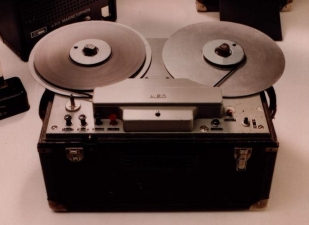
|
|
| 1935 | BASF developes first tape for AEG Magnetophon: "The tape consisted of a foil of cellulose acetate as carrier material, coated with a lacquer of iron oxide (carbonyl iron: light-gray, metallic pure iron) as magnetic pigment and cellulose acetate as binder". |
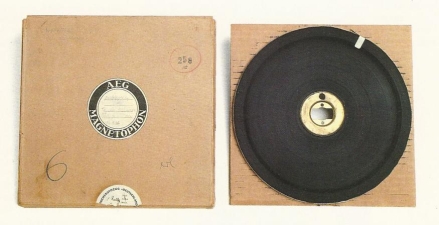
|
|
| 1936 | BASF replaces Carbonyl Iron with Magnetite Fe3O4 (black, cubicular iron oxide). |
| 1936 | The first public recording using the AEG Magnetophon was held on Nov. 19, 1936. The London Philharmonic orchestra conducted by Sir Thomas Beecham played at BASF's own concert hall in Ludwigshaven. |
| 1939 | BASF researchers had advanced the tape quality far beyond its 1936 debut. In summer of 1938 BASF introduced the gamma ferric oxide tape, γ-Fe2O3, with red iron oxide particles, a formula dating back to a 1935 BASF patent. It was not until thirty years later, in 1971 with chromium dioxide tape, that anything fundamentally better would replace it. The γ-Fe2O3 magnetic particles were considerably smaller than the original Fe3O4 formulation, which resisted erasing by the permanent magnet erase heads then in use. With DC-bias AEG Magnetophons, the new tape achieved a signal-to-noise ratio of little more than 40 dB and a frequency response remaining 50 Hz to 5 kHz. |
| 1940 | AC bias is discovered. Reichs-Rundfunkgesellschaft (RRG) engineer Walter Weber discovered the AC-bias application through a combination of systematic research and a bit of luck. Patent DE 743 411. With new tape and AC Bias AEG Magnetophon had achieved 60 dB dynamic range and a frequency response of 50 Hz to 10 kHz. |
| 1943 | BASF produced Tape LG (γ-Fe3O4 on a plastic base film) |
| 1945 | German patent rights on the technology are seized by the U.S. Alien Property Custodian |
| 1946 | Minnesota Mining and Manufacturing ( later 3M Corp. ) introduces Scotch No. 100, a black oxide paper tape. |
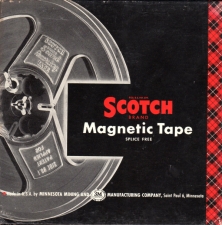
|
|
| 1947 | Bing Crosby agree to audition tape recorders brought in by Jack Mullin and Richard Ranger record Crosby's Philco radio show. Bing Crosby was a big proponent of tape recording. He did not like having to perform his radio broadcasts twice a day, once for the East Coast of the United States and again a few hours later for the West Coast. He figured that if it were recorded (and edited to remove any bloopers or to add different advertisers), he could perform just once. |
| 1947 | Ampex corporation, using Armour Research Foundation and German expertise and designs, produces its first professional tape recorder, the Model 200 |
| 1947 | Scotch types 111 and 112 acetate-base tapes are introduced. |
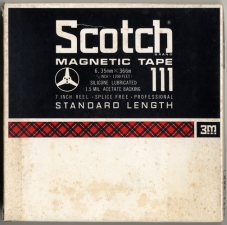
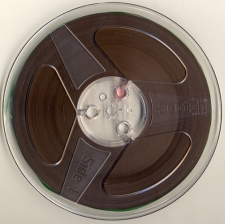
|
|
| 1953 | BASF launched its famous LGS tape series. |
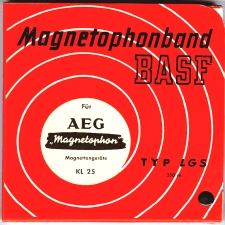
|
|
| 1957 | Stereo recording comes of age. |
| 1961 | BASF launched PES-18 tape. |
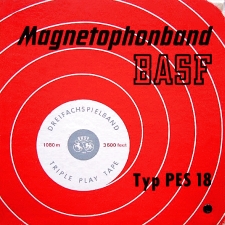
|
|
| 1962 | 3M introduces Scotch 201/202 "Dynarange," a black oxide low-noise mastering tape with a 4 dB improvement in s/n ratio over Scotch 111. |
Cartridges and Cassettes (1958-65)
Launch of tape cartridges by RCA spurred companies worldwide into developing tape cartridges, cassettes and "magazine tapes" under various names and based on different standards. The common feature of these products was, unlike manually threaded reel-to-reel systems, simply inserting the encased tape into a tape player and pressing a button could operate the new systems. People without technical backgrounds could operate it very easily. Naturally, the machine itself could also be miniaturized.|
|
|
| 1958 | RCA cartridge. It was the first attempt to put reel-to-reel tape in cartridge form. Dimensions: 5 x 7 1/8 x 1/2 inches (127 x 197 x 13 mm). The cartridges were reversible and either side could be played. Tape speed was either 3.75 ips resulting in 30 minutes of audio on 0.25 inch tape or 1 7/8 ips selected by a small lever. RCA Records made an early attempt at making this a popular pre-recorded music format. However it turned out to be a major "Flop" in that regard. Cartridges would have prices ranging from $4.95 for a 20 minute tape to $9.95 for an hour RCA was slow to produce machines for the home market and to license recorded music, and the format disappeared from the market by 1964. |
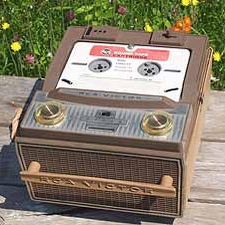
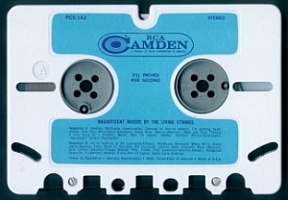
|
|
| 1959 | Fidelipac (NAB cartridge). Introduced in 1959 by Collins Radio at the 1959 NAB Convention. The cart tape format was designed for use by radio broadcasters to play commercials, bumpers and announcements. It will be used until the late 1990s and is on the direct path to the first popular consumer tape format. It was originally a 1/4-inch-wide (6.4 mm) audio recording tape, two-track format at 7.5 ips. Fidelipac cartridge was later adapted by Earl "Madman" Muntz in 1962 for his Stereo-Pak cartridge system (run at 3.75 ips). Muntz also sold a library of 3000 titles licensed from 40 record companies. In the 1960s, Muntz sold about half of the 700,000 Fidelipac-type players. |
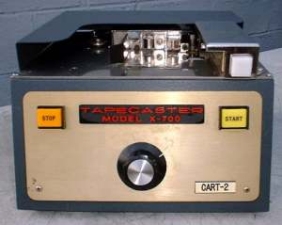
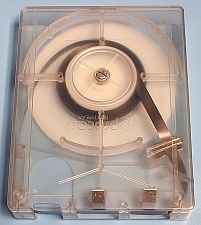
|
|
| 1963 | Compact Cassette Philips introduced a prototype in Europe in August 1963 (at the Berlin Radio Show). Philips cassette was 1/4 the size of the Fidelipac or Lear cartridge, making possible small battery-powered versatile players that could be carried anywhere. It had a reversible housing with maximum tape protection allowing 30 or 45 minutes of stereo music per side. Tape speed: 1 7/8 ips (=4.76cm/s). Tape width: 0.15inch (=3.81mm). In US Philips was using the name NORELCO. Below is the picture of the first cassette player (EL 3300) and the first cassette (it had BASF PES-18 tape inside). |

|
|
| 1965 | DC International. In 1965 during Berlin Exhibition Grundig together with Telefunken and Blaupunkt introduced "DC-International" cassette. The cassette was available in 2x 45 or 2x 90 minutes and run at 5.08cm/s, allowing a 40Hz to 10Khz frequency response. The first recorder was Grundig C 100 L. |
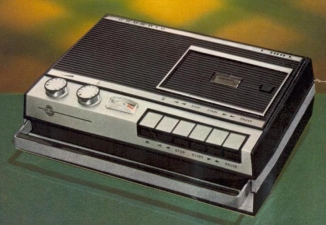
|
|
| 1965 | 8-track. (known also as STEREO 8 and Lear Jet). The cartridge was designed by Lear Jet Corporation in 1964 (by Ralph Miller while working under Bill Lear) for the Ford new car models of 1965, with a tape library provided by RCA Victor. The major change to Fidelipac was to incorporate a neoprene rubber and nylon pinch roller into the cartridge itself, rather than to make the pinch roller a part of the tape player, reducing mechanical complexity. It used only one single reel containing a continuous endless loop of recording tape specifically prepared so that the tape were able to slip out from its inner round of the tape spool. Tape speed: 3.75 ips. Tape width: 0.25 in. |
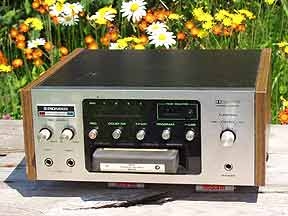
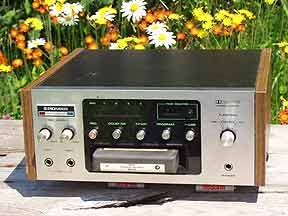
|
The King emerge: Compact Cassette
The rather stiff license fees demanded by the creators were the reasons why Philips and Grundig decided to jointly develop a "Euro" cartridge system. The cooperation did not last long and Philips introduced a prototype in Europe in August 1963 (at the Berlin Radio Show). Scarcely any product has drawn more attention of Japanese industry visitors then the Philips cassette. No doubt it was the most photographed product of that event.
When the cassette was developed there were only three tapes in the world which enabled Philips to get it right, 3M's low-noise cartridge tape, KODAK's triple-play tape P 300 and BASF's PES-18. Of these only BASF tape was perfectly balanced in all its properties, in particular also the mechanical characteristics. Consequently, BASF had the honor to make the very first tapes for the compact cassette.
Grundig was preparing war against the Philips compact cassettes. In 1965 during Berlin Exhibition together with Telefunken and Blaupunkt they introduced "DC-International" cassette system and planned not to ask any license fees. Philips wanted the common license fee for hardware, nothing for music cassettes.
One day in September 1963, at the opening of the Berlin IFA Exhibition, Fredrich Lachner of the German company Grundig proposed to Ohga that the two companies cooperate in developing a DC International Standard for cassette tapes, a standard conceived by three German manufacturers. While Ohga considered this possibility, another proposal came from Wisse Dekker, manager of the Philips Electronics Far East Division and later president, and L.F. Ottens, a technical expert also from Philips. They came to Japan and proposed the co-development of the compact cassette to Ohga. Philips had already developed a compact cassette in 1963. The advantages of both the Grundig and Philips formats were weighed and considered. In the end, Ohga chose the Philips compact cassette because of its smaller size.
A problem over royalties arose during the contract stage. Philips initially suggested that it receive a payment of 25 yen for each unit sold by companies in Japan. Ohga thought this was excessive and did not agree to it. A few days later, Philips showed some flexibility and asked for 6 yen per unit, a figure it said other companies had agreed to. Masanobu Tada, Operations Division manager, recommended that Sony accept the offer, but Ohga still refused, insisting that unless Philips waived royalties altogether, Sony would collaborate with Grundig. Finally, Philips agreed to waive royalties, but did not give Sony exclusive rights to the technology. In 1965, based on a patent that guaranteed compatibility, Philips made the technology available free of charge to manufacturers all over the world.
During first two years everybody has its own name. Sometimes cartridge, sometimes cassette. A uniform name was necessary. The result is well known. Since 1965 the cassette carries the name compact cassette.
The reign: Compact Cassette (1965-90)
The Compact Cassette format initially offered fairly poor fidelity and was marketed for voice recording and dictation. Technology improved quickly, and advances in noise reduction technology, its ability to play stereo tapes, and new tape formulations soon assured high-quality sound from the compact format. Here we present the milestones in Compact Cassette development:|
|
|
| 1963 |
First Compact Cassette. It was loaded with BASF PES-18 tape.

|
| 1968 | TDK SD. First cassette marketed for Hi-Fi market. TDK Super Dynamic. |
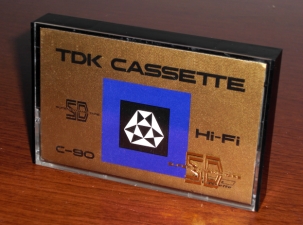
|
|
| 1968 | First C120. |
| 1970 | Dolby B reduction system Based on professional Dolby A. Used a single-channel approach and a viariable high-pass filter controlled by the level in a differential signal path. Dolby B reduced tape signal-to-noise by 9-10 dB. |
| 1970 | DUPONT 'Crolyn' CrO2 tape DuPont invented chromium dioxide, and BASF licensed the technology from DuPont and brought the oxide to its greatest stages of development. Sony got an exclusive right to distribute the pigment in Japan |
| 1971 | Advent Model 201 It was was the first "hi-fi" cassette recorder. It combined Dolby type B noise reduction and chromium dioxide (CrO2) tape, with a commercial-grade tape transport mechanism. This resulted in the format being taken more seriously for musical use, and started the era of high fidelity cassettes and players. |
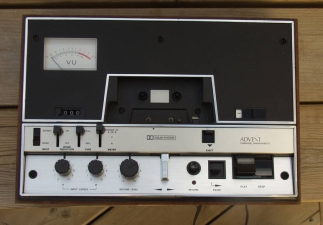
|
|
| 1971 | Equalization of chromium dioxide (CrO2) tape set 70 μs by the DIN committe. The only reason for different equalization was to reduce noise by 4.5 dB - but that came with the cost of reducing SOL. It took more then 10 years to partialy revert that decision. Chrome tapes at 120 μs equalization was used by A & M Records to release high quality recored albums (The first release was Supertramp’s “Famous Last Words” in 1982. The follow up release was the Police’s “Synchronicity,” a huge hit world-wide. ) |
| 1972 | SCOTCH High Energy Cobalt dotted cassette |
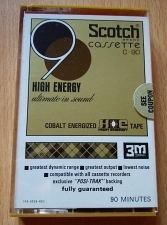
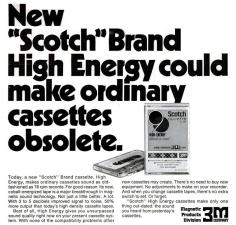
|
|
| 1972 | First C180. TDK C-180LN |
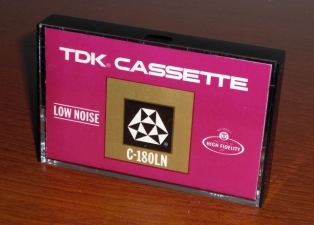
|
|
| 1972 | TEAC A450 |
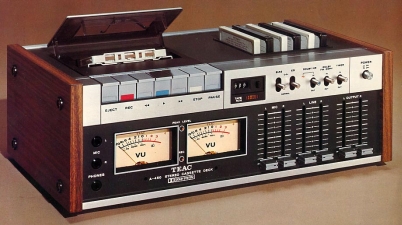
|
|
| 1973 | MO 2228 pigment of Pfizer. Produces new generation of Ferric tapes (AGFA, AMPEX, BASF, MEMOREX). Japanese companies did not follow that path and that created chaos - we have "normal bias" and "high bias" setting for type I tapes. |
| 1973 | Nakamichi 1000 |
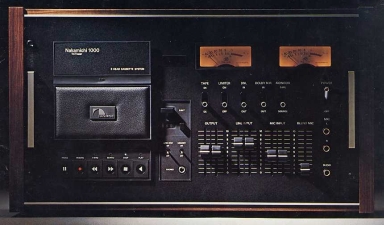
|
| 1975 | Sony Ferrichrome. Sony developes double layer Ferrichrome tape (thiner chrome coat lie on a top of gamma ferric pigment). Since SONY had exclusive right to chrome pigment in Japan. Maxell, TDK and FUJI decided to purse other possibilities to replace chrome pigment with cobalt dotted ferric. It took Japanese chemists to fix the cobalt ions to the outside crystalline structure (epitaxial) or within the structure (adsorptive Avilyn) to stabilize the pigment and get away from having to pay Sony for American oxide. As a result TDK develops AVILYN, Maxell developes EPITAXIAL and FUJI develops BERIDOX. Also TDK, Maxell and FUJI are not able to produce FerriChrome tapes. |
| 1978 | Scotch Metafine. Metal tape is produced by coating a plastic film with metal powder (MP tape). MP tape needs a new heads made from the magnetic material which will not saturate with its own flux before the tape records the signal. Only amorphous metal or Sedust alloy could cope. Matsushita makes a ME metal tape by evaporating metal in a vacuum so that a vapour deposits itself on the plastic film. ME proved to be difficult and expensive to mass-produce. |
| 1978 | IEC type I,II,III and IV classification was approved. BASF made two IEC I reference tapes. The first was a former DIN tape adopted by the IEC, and it was superseded by a better ferric oxide formula later on. There were three IEC II reference tapes: 1) was a former DIN chrome; 2) the second was a significantly improved chrome; and 3) the last was a ferric-cobalt tape. Sony made the IEC Type III reference tape, and TDK made the Type IV reference tape. The idea for reference tapes originated with BASF in the very early days as a way to compare improvements. The standards became part of Deutsche Industrie Normen (DIN) and later the IEC (International Electro-Technical Commission). This was important for consumer compatibility (in theory, because in practice the Japanese companies set their equipment up for the Japanese tape) and essential for high-speed duplicators who ran hundreds of miles of tape per day on each machine. |
| 1979 | SONY Walkman. Model TPS-L2. The first truly self-contained portable music system, the TPS-L2 Walkman cassette player. 37. The Walkman's real innovation was its size, measuring only slightly larger than a cassette tape itself. Featuring a pair of portable, lightweight headphones and operating on AA batteries, it ushered in a new era of portability. The original Walkman retailed for 33,000 Japanese Yen |


|
|
| 1979 | Noches for automatic tape type recognition were introduced. |

|
| 1980 | Dolby C. Basically using two Dolby B in series. Dolby C reduced tape signal-to-noise by 20 dB. |
| 1984 | Sales of recorded compact cassettes (audio cassettes) exceed LP sales for the first time. |
| 1990 | Dolby S. Based on an advanced profesional spectral recording system. Dolby C reduced tape signal-to-noise by 24 dB. |
| 1990 | Super metals. High end metal cassettes were introduced: TDK MA-XG, Metal Vertex, Sony Metal Master, That's Suono. |

|
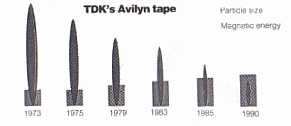
|
Reference and Contributors:
- Terry O'Kelly (email exchange)
- Willem Andriessen, `THE WINNER'; compact cassette. A commercial and technical look back at the greatest success story in the history of AUDIO up to now. Journal of Magnetism and Magnetic Materials, Volume 193, Issues 1-3, March 1999, Pages 11-16
- AES Society files. http://www.aes.org/aeshc/docs/audio.history.timeline.html
- Magnetic recording: the first 100 years (Edited By Eric D. Daniel, C. Denis Mee, Mark H. Clark) Wiley-IEEE Press (August 17, 1998).
- Philips: http://www.philipsmuseumeindhoven.nl/phe/products/e_cc.htm
- SONY: http://www.sony.net/SonyInfo/CorporateInfo/History/SonyHistory/2-05.html
- "sowa_pszemodzala" for picture of the first Compact Cassette.
- Wilhelm from "Tapeheads" for picture of Magnetophon K1 recorder and Magnetophonband Type C tape.

